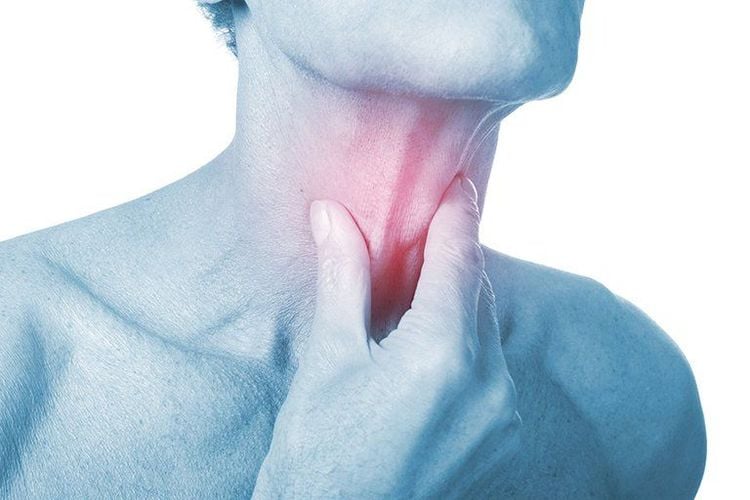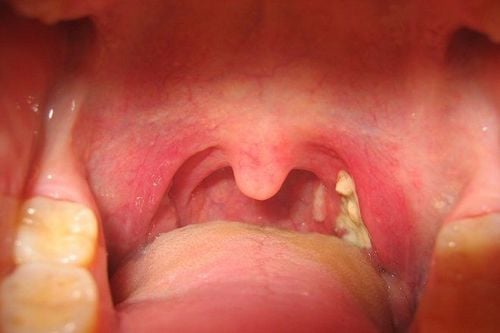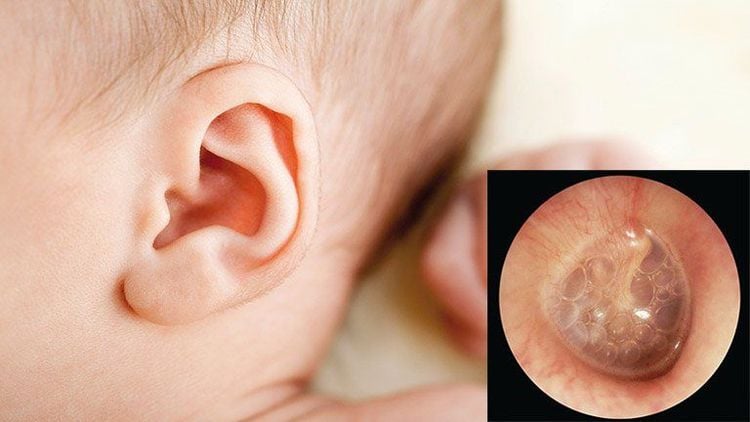This article is professionally consulted by ENT doctors of the Department of Outpatient & Internal Medicine at Vinmec Hai Phong International General Hospital.
Lingual tonsillitis is an upper respiratory tract condition caused by pathogenic agents attacking the lingual tonsils, leading to inflammation.
1. What Is Lingual Tonsillitis?
Tonsils are lymphoid tissues that provide local immune responses against pathogens, preventing them from causing respiratory tract infections. The tonsillar tissue in the throat area forms a ring known as Waldeyer’s ring. Lingual tonsils are part of this lymphoid ring but are less frequently mentioned.
Lingual tonsillitis refers to inflammation of the lymphoid follicles at the base of the tongue when they are attacked by disease-causing pathogens.
2. Symptoms of Lingual Tonsillitis
Common symptoms include:
- The most typical sign is pain when swallowing saliva, food, or beverages. Patients may feel as if a foreign object is stuck in their throat, causing discomfort and sometimes difficulty speaking. The tongue may appear coated, with a pale whitish film.
- The nature of the pain: Pain may spread to the area behind the ears, worsen with dry coughs, and increase when swallowing food or saliva, severely affecting eating and daily communication.
- Fever: Patients may experience a mild fever during the acute inflammatory phase.
- The throat area around the tonsils and the base of the tongue may feel hot, swollen, red, and dry, more so than usual.
If a virus is the cause, the patient may have conjunctivitis or a runny nose. - Lingual tonsillitis can cause wheezing or noisy breathing.
- If bacteria are involved: The lingual tonsils may swell, small pus-like spots or white patches can be seen in the throat, swollen and painful lymph nodes at the jaw angle, fever, fatigue, and sore throat.
- The infection can spread to other areas such as the larynx, bronchi, and trachea, leading to laryngo-tracheo-bronchitis, causing fever, cough, phlegm, hoarseness, increased mucus, chest pain, and general discomfort.
- Other symptoms: Fatigue, loss of appetite, headaches, and bad breath.

3. Causes of Lingual Tonsillitis
Similar to other tonsillar inflammations in Waldeyer’s ring, pathogens can include:
- Viruses: Viruses causing upper respiratory infections can lead to lingual tonsillitis. They enter the respiratory tract through contact with infected secretions or contaminated food and drink. A common virus involved is the Epstein-Barr virus.
- Bacteria: The most common bacterial cause is Group A Streptococcus. Other bacteria that infect the throat area can also cause lingual tonsillitis, such as gonococcus or Chlamydia.
- Fungi: Fungal infections can also cause inflammation of this tonsillar tissue.
Factors leading to microbial attacks include poor oral hygiene, direct contact with infected individuals without protective measures, infections spreading from other upper respiratory sites (such as chronic rhinitis or sinusitis), weakened immunity, and environmental changes that facilitate microbial growth.

4. Treatment of Lingual Tonsillitis
Treatment depends on the cause and the patient’s clinical presentation. It can be medical (conservative) or surgical.
4.1 Medical (Conservative) Treatment
Indicated for acute lingual tonsillitis:
- Symptomatic treatment: Depending on symptoms, use pain relievers, anti-inflammatory, antipyretics, and anti-edema medications. If there’s cough with phlegm, use expectorants and anti-inflammatory agents.
- If bacterial: Use antibiotics orally or in combination with topical antiseptics (lozenges, sprays).
- If fungal: Use antifungal medications.
- Supportive care: Ensure a balanced diet, adequate fluid intake, gargle and rinse the mouth regularly with saline, maintain good oral hygiene.
4.2 Surgical Treatment
Indicated when:
- Recurrent episodes multiple times a year (5-6 times/year).
- Enlarged lingual tonsils obstructing the airway, causing sleep apnea syndrome and oxygen deficiency.
- No response to conservative treatment.
- Complications spreading to nearby organs (otitis media, sinusitis, lower respiratory infections).
Surgical methods vary:
- Traditional dissection with scalpel and snare: Heals well but may have more bleeding.
- Sluder-Ballenger technique: Less common now due to cosmetic results and requires experienced surgeons.
- Coblation method: Less damage to surrounding tissue, faster healing, minimal bleeding, but higher cost

5. Prevention of Lingual Tonsillitis
Preventive measures include:
- A balanced diet, avoid spicy foods, stimulants, smoking, limit alcohol. Exercise regularly to boost immunity.
- Ensure sufficient fluid intake.
- Maintain daily oral hygiene, gargle with saline.
- Treat oral, nasal, and throat conditions promptly to prevent spread to lingual tonsils.
Lingual tonsillitis can cause serious complications depending on the pathogen. Early and proper treatment is crucial to avoid severe outcomes.
At Vinmec International General Hospital, doctors examine and treat common nasal and throat infections, head and neck tumors, and congenital abnormalities of the ENT area using optimal medical and surgical methods for both children and adults. Patients receive thorough, professional care from highly skilled and experienced healthcare professionals.
To arrange an appointment, please call HOTLINE or make your reservation directly HERE. You may also download the MyVinmec app to schedule appointments faster and manage your reservations more conveniently.









